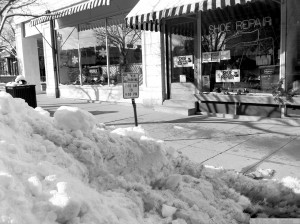Clearing the Snow
Adele Crandell Durkee — February 9, 2015Snow shoveling is weight bearing, cardio-vascular exercise that burns about 354 calories an hour. That’s more than a brisk walk, more than a workout on the elliptical, more than jogging, and just enough to nullify the hot cocoa and warm chocolate cookies consumed afterwards.
Snow shoveling can result in orthopedic injury or heart attack. So, it’s wise to take precautions. Here are 10 tips for safe snow shoveling:
1. Get the right shovel.
a. A curved handle allows you to keep your back straighter when shoveling.
b. The correct handle length results in slightly bent knees, with back flexed at 10 degrees or less at the start of the “shoveling stroke.”
c. A light plastic shovel blade puts less strain on your spine.
d. A small blade avoids the risk of trying to pick up too heavy of a pile of snow.
2. Use proper technique:
a. Hands should be at least 12 inches apart when gripping the shovel.
b. Squat with your legs apart and back straight.
c. Do not bend at the waist.
d. Move your feet rather than twisting.
3. Push the snow, rather than lift it. A wet snow can result in 100 pounds to a ton of lifting. One shovel full of snow can weigh as much as 25 pounds. Pushing puts far less strain on the back.
4. Dress in breathable layers that can be peeled off as the body heats up.
5. Work piecemeal and get a head start whenever possible. Shoveling as the snow accumulates may seem like a fruitless endeavor, but it makes the chore more enjoyable and creates less strain on the body.
6. Clear snow with a buddy and help a neighbor. Working together makes the chore more pleasant and safer. A few moments to help a neighbor might save a life.
7. Stay hydrated and take frequent breaks.
8. Be aware of road conditions and traffic. Vehicles can slip and slide into driveways and injure people clearing their drive and walkways.
9. Seek medical attention if pain occurs or if unexpected chest tightness, shortness of breath, or pain or burning in the chest, jaw or shoulder occurs. Across the nation, more heart attacks occur in winter than in summer.
10. Consider getting a snow blower.
People with a known heart condition should avoid shoveling snow. Smokers, people with a family history of heart disease or those with high blood pressure, those who are middle-aged or older should be cautious about shoveling snow.
It’s a good idea to carry a cell-phone, just in case an emergency occurs. An immediate response to a slip or fall could mean the difference between life and death.
Remember to enter ICE as a cell phone contact. ICE stands for “In Case of Emergency.” Information should include phone numbers of family or friends and your primary care physician, along with information about medical conditions, handicaps, medication, and allergies. First responders are trained to look for ICE when injured patients are unconscious or unable to communicate.








